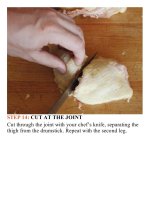The food lab better home cooking through science ( PDFDrive ) 1072
Bạn đang xem bản rút gọn của tài liệu. Xem và tải ngay bản đầy đủ của tài liệu tại đây (215.98 KB, 2 trang )
ofoil,andyou’relookingatadropcloserto50degrees.So
at home, you have to heat your oil hotter in order to
compensateforthisloss.
Q:OK,IthinkI’vegotit:Newoil=good,oldoil=bad,
right?
Not necessarily!You may think that using fresh new oil is
the best way to fry foods, and you would be forgiven for
thinkingthat.Forgiven,butwrong.Here’swhy:
Completely fresh oil is highly hydrophobic: it doesn’t
want to get anywherenear water.Any food that you drop
intoadeepfryerisboundtohaveaverylargepercentageof
waterinit(afterall,thewholepointoffryingistodriveoff
water), which means that the oil isnot going to like it. It
hates it so much, in fact, that it has trouble getting close to
its surface. Have you ever noticed that when you drop
batteredfoodintofreshoil,there’sashinybubblethatforms
around the food? That’s a layer of water vapor rapidly
escapingfromitssurfaceandpreventingthefatfromgetting
too close. Because the fat can’t come in contact with the
food, heat transfer is inefficient with fresh oil.This means
longercookingtimes,lesscrispness,andless“fried”flavor
(remember, fried flavor comes from a combination of
browning, dehydration, and fat absorption—see “What Is
Deep-Frying?,”here).
Slightly older oil, on the other hand, has got a few
surfactants in the mix—those molecules that allow fat and
watertocomeclosetoeachother.Becauseofthat,olderoil
isbetterabletopenetratefoods,cookingthemfarfasterand
givingyoucrisper,better—flavoredcrusts.
Asanylongtimefrycookwilltellyou,youshouldalways
save a bit of the old fry oil to add to the new batch if you
want to make sure your foods come out at optimum
crispness right from the first batch of fresh oil. For home
cooks,thisamountcanbeaslittleasatablespoonofoldoil
perquartofnewoil.
Q:WhatshouldIdowiththeoilinbetweenbatchesof
frying?
Just as with fresh oil, used oil should be stored in a cool,
dark, relatively airtight environment. If you are planning to
doabunchoffryingoverthecourseofafewdays,thiscan
be as easy as straining it through a fine-mesh strainer lined
withcheeseclothorapapertowelintoapotwithametallid
(notglass—glassletsinlight)andkeepingitinacoolcorner
of the kitchen. For longer-term storage, strain the used oil
through a fine-mesh strainer, then funnel it back into its
original packaging. Seal tightly and store it in a cool, dark
cabinet.
Q:AndwhatshouldIdooncetheoilfinallydoesreach
thepointwhereitcan’tbereusedanymore?HowdoI
getridofit?
Discarding used oil can be a real pain in the butt. Small
amounts, say, less than a half cup or so, can be poured
down the drainwith plenty of soap and warm water (the
soap helps the oil emulsify with the water, preventing it
from sticking to and coating the insides of your pipes), but
largeramountsrequireabitmorecare.
Theabsolutebestwaytogetridofusedoilistodonateit









